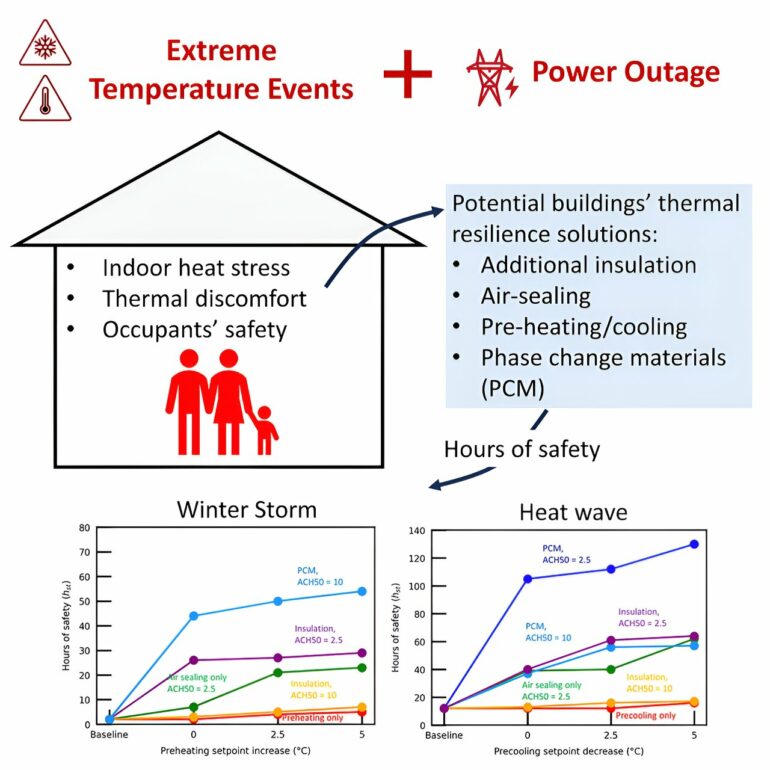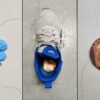Bitter cold temperatures. Unrelenting heat. Power outages that last for weeks. National Renewable Energy Laboratory (NREL) researchers are planning for extreme weather by calculating what it will take to make the situation survivable.
A newly published study from NREL uses a computer model to examine methods that increase occupant safety, which was defined by how many hours it took for the indoor temperature to reach a certain point. During a winter storm, the safety threshold was above 59°F. In a heat wave, the threshold was below 91°F.
The study focuses on retrofit options for existing buildings and finds that while adding insulation and sealing the home against air leaks will increase resilience, the use of phase-change materials (PCM) will significantly enhance hours of safety. PCMs are designed to store either heat or cold, do not require electricity, and can be effective even if only used in a smaller space.
“Practically, it could make more sense to add PCMs in a small bedroom or closet than the entire house,” said Ravi Kishore, an NREL senior research engineer and co-author of “Enhancing thermal resilience of U.S. residential homes in hot humid climates during extreme temperature events.” The paper, which is published in the journal, Cell Reports Physical Science, was coauthored by NREL’s Sajith Wijesuriya, Marcus Bianchi, and Chuck Booten.
Using the NREL-developed ResStock residential building model, the researchers calculated the hours of safety that a resident of a single-family home would have during an extreme weather event. The computer model based its calculations on a typical 2,000-square-foot home built in Houston, Texas, in the 2000s. Although the work focused on a particular city, the researchers said the findings are applicable to other communities battered by extreme weather.
A baseline scenario, in which no action was taken to mitigate the temperature extremes during a power outage, determined that the safety of occupants would be compromised in two hours during a cold snap and in 12 hours during a heat wave.
Improvements that included PCMs as a thermal energy storage solution extend this time to 44 hours in the cold and to 37 hours in the heat without any preconditioning. Homes in areas with both temperature extremes should consider two types of PCMs, arranged in layers because each material has different melting ranges.
Phase change materials to improve building resilience
PCMs store thermal energy to maintain the temperature of the building longer and can be integrated in walls and ceilings. PCMs remain in a liquid state during a typical winter day and are solid during an average summer day. When extreme weather conditions hit, the PCM reacts when the temperature reaches a certain point. During a heat wave, for example, the PCM gradually liquifies and absorbs heat, preventing a sudden increase in the indoor air temperature.
The thickness of PCM plays a role in how resilient the building is to extreme temperatures. The thicker the material, the greater the thermal resilience. The computer model for this new study used three-quarters of an inch as the default thickness, and assumed the PCM was fully frozen before a heat wave and fully melted before a winter storm. The placement of the PCM also proved important in extending the number of hours before an occupant’s health is threatened.
Thermal energy storage research at NREL
NREL is advancing the viability of PCMs and broader thermal energy storage (TES) solutions for buildings through the development, validation, and integration of thermal storage materials, components, and hybrid storage systems. TES systems store energy in tanks or other vessels filled with materials—such as ice, wax, salt, or sand—for use at a different time. For example, TES systems can store excess solar or wind energy for a use during a time when the sun has set or the wind is not blowing.
TES technologies have many applications, from grid-scale energy storage to building cooling and heating storage. When packaged into a device, these “thermal batteries” contain a storage material, heat exchangers to supply and extract the stored heat, and insulation to prevent the stored heat from escaping.
A recent journal article published in Energy & Environmental Science by NREL researchers Jason Woods, Wale Odukomaiya, Allison Mahvi, and Shannon Yee describes cost-scaling analysis for thermal batteries, which considers the properties of the material, heat exchanger, and insulation. This information can help researchers determine which technologies will have the largest impact on reducing the overall system cost.
The NREL-led Energy Earthshot Research Center project Degradation Reactions in Electrothermal Energy Storage (DEGREES) focuses on advancing our fundamental understanding of the degradation mechanisms of materials for electrothermal long-duration energy storage.
Numerous partners from national laboratories and universities are working together to understand degradation, learn to control it, and rapidly translate this knowledge to improve long-duration energy storage. This storage is essential for supporting an electric grid with more renewables.
Leveraging collaborative TES research will help level out peak energy demand, reduce potential grid outages, and enable more cost-effective electrification of buildings. As a codirector of the Stor4Build consortium, NREL is supporting crosscutting research to accelerate the development, growth, optimization, and deployment of cost-effective TES technologies that benefit all communities. Stor4Build research at NREL includes investigating novel TES materials and systems, which can adjust when heating or cooling is created, stored, and delivered.
More information:
Sajith Wijesuriya et al, Enhancing thermal resilience of US residential homes in hot humid climates during extreme temperature events, Cell Reports Physical Science (2024). DOI: 10.1016/j.xcrp.2024.101986
Jordan D. Kocher et al, Thermal battery cost scaling analysis: minimizing the cost per kW h, Energy & Environmental Science (2024). DOI: 10.1039/D3EE03594H
Provided by
National Renewable Energy Laboratory
Citation:
Thermal energy storage and phase change materials could enhance home occupant safety during extreme weather (2024, July 1)



